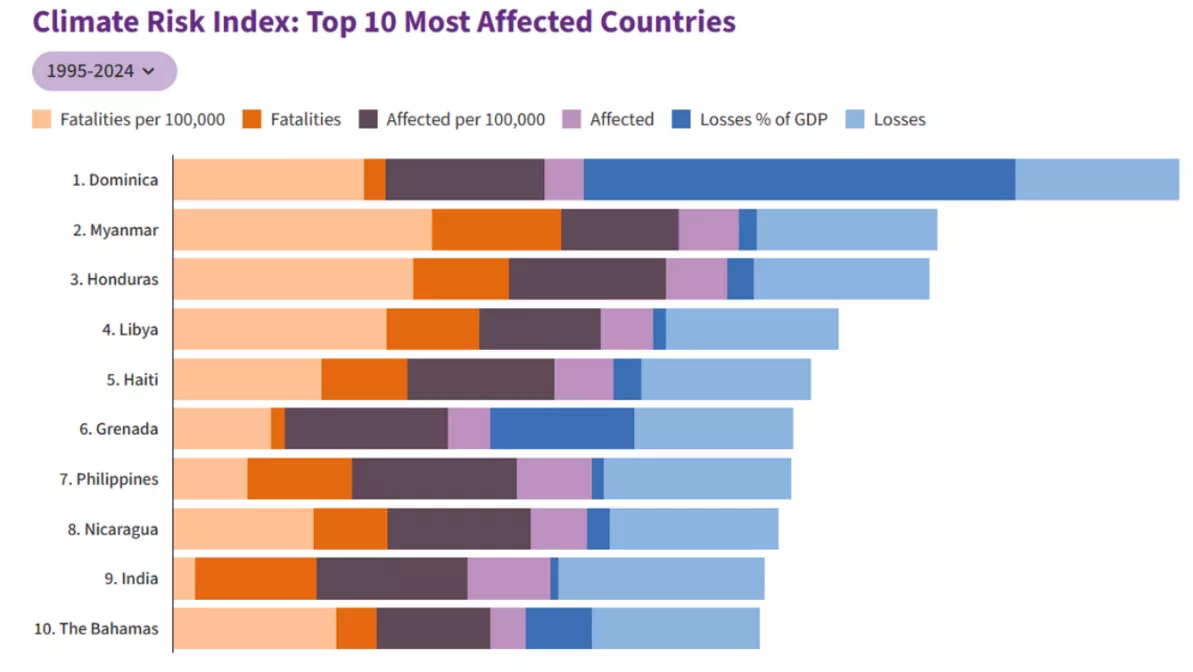India, ranked 9th among countries most affected by extreme weather (1995–2024), according to Germanwatch’s Climate Risk Index (CRI) 2026, released at COP30 (Belem, Brazil, Nov 2025).
Key Findings

- South-South Vulnerability: All top ten most affected countries (1995–2024) are from the Global South.
- Saint Vincent and the Grenadines was the worst affected in 2024, followed by Grenada and Chad.
- Persistent Threat: Countries like India, Philippines, Nicaragua, and Haiti are categorized as “continuous threats,” meaning they face frequent, repeated extreme weather, making recovery challenging.
- They are hit by floods, heatwaves, or storms so regularly that entire regions can hardly recover from the impacts until the next event strikes.
- Unusually Extreme weather Events: Dominica, Myanmar, Honduras, and Libya are placed at an even higher risk because they experience unusually extreme weather events.
- Global Death Toll: Over 832,000 killed by 9,700 extreme weather events worldwide (1995–2024).
- Cyclone Nargis, which hit Myanmar in 2008, was one of the worst disasters in the last three decades, killing around 1,40,000 people and accounting for more than 95% of fatalities in the country in this period.
- Economic Losses: Over $4.5 trillion globally due to these events in the same period.
- In 2024 alone, floods affected almost 50 million people globally, followed by heatwaves (33 million) and droughts (over 29 million).
India-Specific Findings
- India ranks ninth overall for most affected countries (1995–2024), and ranked 15th in 2024.
- Frequency: India endured around 430 extreme weather events in the last 30 years, impacting over a billion people.
- Economic Impact: Cumulative inflation-adjusted losses of approximately $170 billion.
- Fatalities: More than 80,000 people killed in these events.
- Major events:
- 1993 floods in several northern states (Punjab, Haryana, etc)(925 killed).
- 1998 Gujarat cyclone (1,173),
- 1998 heatwave in several parts of the country (Odisha, Bihar, etc.) (2,800 Fatalities)
- 1999 Odisha super cyclone (9,885), 2002–03
- Other Extreme Weather Events: heatwaves, 2013 Uttarakhand floods (5,000), 2015 heatwave (2,000+), 2019 floods & cyclones, 2020 Cyclone Amphan, etc
- 2024 monsoon: Particularly severe, affecting over 8 million people, largely in Gujarat, Maharashtra, and Tripura.
- In 2024, India ranked third globally for people most affected by extreme weather (after Bangladesh and the Philippines).
- Continuous Threats: India struggles to recover between disasters, with cumulative impact worsening due to high frequency of floods, heatwaves, and cyclones.
- The report also highlights gaps in data for the Global South, implying India’s actual impacts may be underreported.
About Climate Risk Index (CRI)
- Definition: The CRI is an analytical index by Germanwatch that ranks countries based on human and economic impacts of extreme weather events (EWE).
- Genesis: Published annually since 2006, the CRI uses data from Munich Re NatCatSERVICE and IMF.
- Not a binding UN index, but widely cited in UNFCCC and IPCC discussions.
- Criteria/Method:
- Based on fatalities per 100,000 inhabitants and economic losses (in PPP USD).
- Focuses on rapid-onset events — floods, storms, heatwaves, droughts, wildfires, glacial lake outbursts.
- Excludes slow-onset events like sea-level rise or ocean acidification.
- Purpose: Indicates climate vulnerability and loss and damage exposure; used to push for climate finance and adaptation measures under COP negotiations.
- Implications: India is in the “continuous threats” category (with Philippines, Haiti, Nicaragua), meaning recurring disasters prevent recovery.
- The CRI ranking strengthens India’s claim for loss and damage funding at COP30.
![]() 12 Nov 2025
12 Nov 2025



